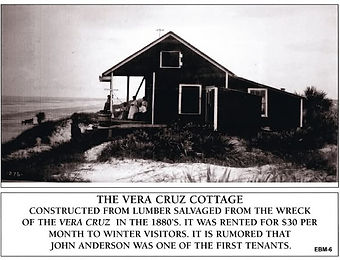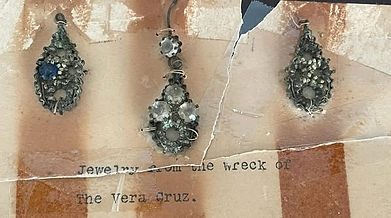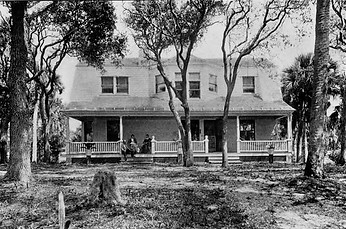The Wreck of the City of Vera Cruz
As caretakers of the Nathan Cobb Cottage, we often tell the tale of this home built from the wreck of the schooner Nathan F. Cobb, which ran aground on Ormond’s shore in 1896. But sixteen years earlier, another cottage emerged—born from the wreckage of another tragic disaster.
In late August and early September of 1880, a powerful hurricane swept across the East coast of Florida, leaving a path of destruction and claiming numerous lives. The storm battered ships off the Atlantic shore, and at least six vessels were wrecked between Matanzas Inlet and Cape Canaveral.
Among the lost ships, the most tragic was the City of Vera Cruz, a steamship traveling from New York to Vera Cruz, Mexico, with over 100 passengers on board. As monstrous waves broke the vessel apart, passengers and crew were thrown into the raging sea. Only a handful made it to shore alive. Eyewitnesses recalled that the storm’s fury was so intense, it tore the clothing from the survivors and even stripped away layers of their skin. Some endured more than 20 hours in the water before reaching land.
The aftermath was horrific. Bodies from the Vera Cruz washed ashore for miles. One settler reported that looters scavenged the dead, even ripping jewelry from the ears of women. In response, local residents formed a makeshift “vigilance committee” to bury the victims and protect them from wild hogs. Sixty-seven bodies were laid to rest in a mass grave just beyond the dunes north of the Number Nine Plantation. A large upright timber once marked the site, but it was eventually lost to the Florida environment.
Of the many souls aboard the City of Vera Cruz, only eleven men are believed to have survived.


As the wreckage drifted ashore, settlers worked day and night salvaging cargo—sometimes to the point of exhaustion. One account tells of weary salvagers resting atop their recovered goods, only to awaken and find that others had quietly lifted the boards from beneath them and stolen their haul. The storm had cast up an astonishing variety of cargo: barrels of premium lard, slabs of salt pork, crates of whiskey, canned goods, bolts of cloth, furniture, jewelry, and kerosene. For years afterward, coastal women were seen wearing fine silks and satins recovered from the ill-fated ship.
Some of the ship’s remnants were repurposed in remarkable ways. A beach cottage built from the wreckage was named the Vera Cruz, though it no longer stands today. In Daytona, a family constructed a beautiful, large-rigged sloop from mahogany planks that had washed ashore, naming it the Mary Hoag. Chauncey Bacon used some of the same mahogany to craft a mantel and heavy doors—at Number Nine Plantation on John Anderson Drive, where they remain beautifully intact today.
The City of Vera Cruz was not the only casualty of the storm. An English ship carrying black walnut and other fine lumber from Fernandina to Rio de Janeiro sank just south of Ormond. Another lumber ship met a

Number Nine Plantation
similar fate in the same area, while two schooners and a large steamship carrying general merchandise were beached near Mosquito Lagoon (now Ponce Inlet). For the settlers, the storm’s destructive path unexpectedly delivered a bounty. Some concealed their finds in cisterns or other hiding places to avoid surrendering them to insurance agents dispatched to reclaim the cargo. This prompted Mayor G.M. Wallace and Justice of the Peace L.D. Huston to publish a notice urging residents to inventory and hold recovered property “for the credit of our community and the reputation of our families.”



